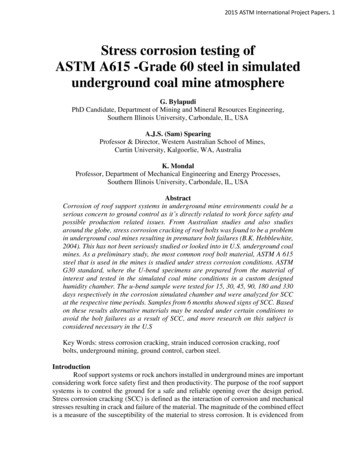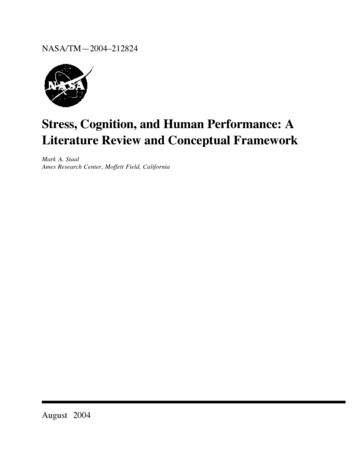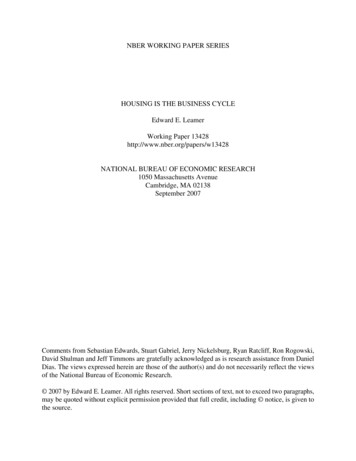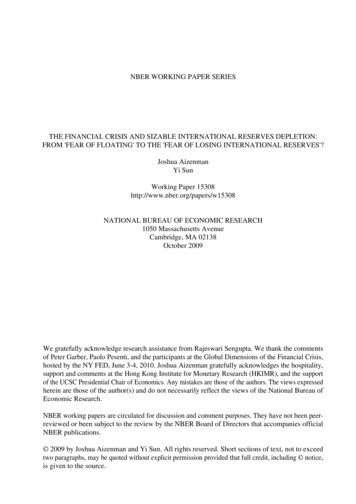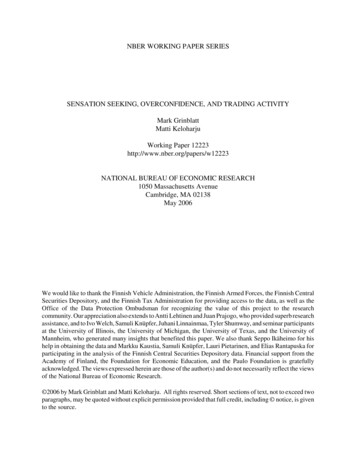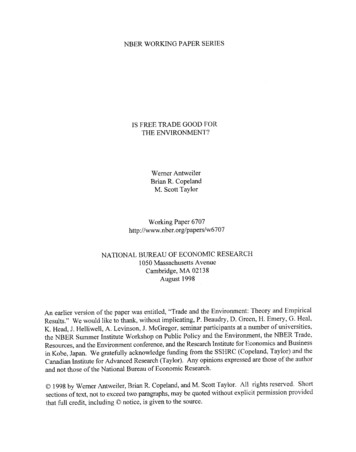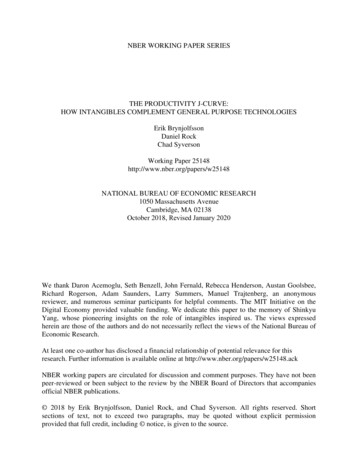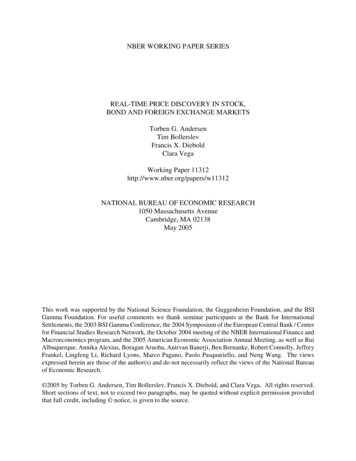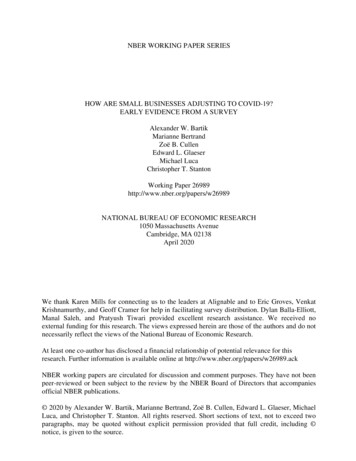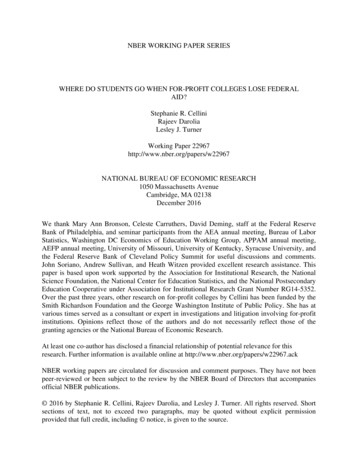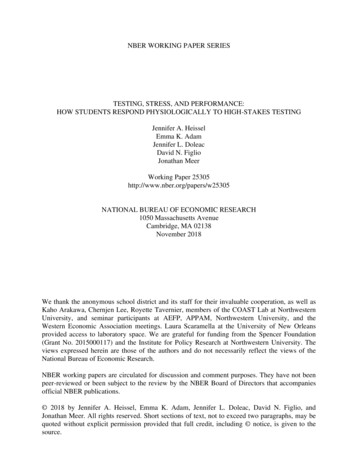
Transcription
NBER WORKING PAPER SERIESTESTING, STRESS, AND PERFORMANCE:HOW STUDENTS RESPOND PHYSIOLOGICALLY TO HIGH-STAKES TESTINGJennifer A. HeisselEmma K. AdamJennifer L. DoleacDavid N. FiglioJonathan MeerWorking Paper 25305http://www.nber.org/papers/w25305NATIONAL BUREAU OF ECONOMIC RESEARCH1050 Massachusetts AvenueCambridge, MA 02138November 2018We thank the anonymous school district and its staff for their invaluable cooperation, as well asKaho Arakawa, Chernjen Lee, Royette Tavernier, members of the COAST Lab at NorthwesternUniversity, and seminar participants at AEFP, APPAM, Northwestern University, and theWestern Economic Association meetings. Laura Scaramella at the University of New Orleansprovided access to laboratory space. We are grateful for funding from the Spencer Foundation(Grant No. 2015000117) and the Institute for Policy Research at Northwestern University. Theviews expressed herein are those of the authors and do not necessarily reflect the views of theNational Bureau of Economic Research.NBER working papers are circulated for discussion and comment purposes. They have not beenpeer-reviewed or been subject to the review by the NBER Board of Directors that accompaniesofficial NBER publications. 2018 by Jennifer A. Heissel, Emma K. Adam, Jennifer L. Doleac, David N. Figlio, andJonathan Meer. All rights reserved. Short sections of text, not to exceed two paragraphs, may bequoted without explicit permission provided that full credit, including notice, is given to thesource.
Testing, Stress, and Performance: How Students Respond Physiologically to High-StakesTestingJennifer A. Heissel, Emma K. Adam, Jennifer L. Doleac, David N. Figlio, and Jonathan MeerNBER Working Paper No. 25305November 2018JEL No. I21,I24ABSTRACTA potential contributor to socioeconomic disparities in academic performance is the difference inthe level of stress experienced by students outside of school. Chronic stress – due toneighborhood violence, poverty, or family instability – can affect how individuals’ bodiesrespond to stressors in general, including the stress of standardized testing. This, in turn, canaffect whether performance on standardized tests is a valid measure of students’ actual ability.We collect data on students’ stress responses using cortisol samples provided by low-incomestudents in New Orleans. We measure how their cortisol patterns change during high-stakestesting weeks relative to baseline weeks. We find that high-stakes testing does affect cortisolresponses, and those responses have consequences for test performance. Those who respondedmost strongly – with either a large increase or large decrease in cortisol – scored 0.40 standarddeviations lower than expected on the on the high-stakes exam.Jennifer A. HeisselGraduate School of Business andNaval Postgraduate School555 Dyer RoadMonterey, CA 93943jaheisse@nps.eduEmma K. AdamSchool of Education and Social PolicyNorthwestern University2120 Campus DriveEvanston, IL 60208United Statesek-adam@northwestern.eduJennifer L. DoleacDepartment of EconomicsTexas A&M UniversityCollege Station, TX 77843jdoleac@tamu.eduDavid N. FiglioInstitute for Policy ResearchNorthwestern University2040 Sheridan RoadEvanston, IL 60208and NBERfiglio@northwestern.eduJonathan MeerDepartment of EconomicsTexas A&M UniversityCollege Station, TX 77843and NBERjmeer@econmail.tamu.edu
1. IntroductionThe results of high-stakes standardized tests determine course placement, graduation, and college admission for students, result in sanctions or rewards for schools, andinform education policy. There is substantial resistance to testing regimes, often predicatedon the notion that students are “stressed” by tests.1 Yet, to our knowledge, no evidenceexists on test-induced physiological stress among K-12 students in a real-world setting.2Understanding variation in test-induced stress responses and implications for performanceis important for determining whether scores on high-stakes tests are reliable measures ofability and knowledge, or if they are biased by “stress disparities” between children (seereview in Heissel, Levy, & Adam, 2017).This study makes clear the potential policy implications of high-stakes test-inducedstress. We document how high-stakes testing affects low-income children’s stress biology,and we show how changes in children’s physiological responses to high-stakes tests affectperformance on standardized tests. Knowing the answers to these questions affects our understanding of how high-stakes test results should be used and interpreted.We use saliva-based measures of cortisol – a primary stress hormone that indicateshow the biological stress system is functioning – among low-income students in New Orleansto document how cortisol levels change (“cortisol reactivity”) in response to a high-stakesstandardized test administered to students in grades 3-8, relative to a regular baseline school1The Center for American Progress found that 49% of parents thought that there was too much testing inschools (Lazarín, 2014), and the New York Association of School Psychologists provides an overview ofmany reported parent concerns (Heiser et al., 2015). These concerns are not unfounded: grade 3-5 studentsreported higher anxiety and stress symptoms following No Child Left Behind-required testing, relative tolower-stakes classroom testing (Segool, Carlson, Goforth, Embse, & Barterian, 2013).2A variety of studies have examined cognitive tests in lab settings (Lupien et al., 2002; Stroud, Salovey, &Epel, 2002) or with researcher-administered tests in schools that did not matter for student or school outcomes (Blair, Granger, & Razza, 2005; Lindahl, Theorell, & Lindblad, 2005). These studies do not includebaseline, non-testing weeks in their analysis. Other studies have looked at adult responses in undergraduateand medical students (Malarkey, Pearl, Demers, Kiecolt-Glaser, & Glaser, 1995; Weekes et al., 2006).
2week. We then examine whether differences in cortisol reactivity are associated with performance on the test. We find that students have 15% higher cortisol levels in the homeroomperiod just before taking the high-stakes test, relative to that same timeframe during weekswithout testing. These differences are driven by boys, whose homeroom cortisol is 35%higher during testing weeks than regular weeks.3 While our entire sample can be consideredeconomically disadvantaged, we also find suggestive evidence of differences by level of disadvantage, with the largest cortisol effects for those living in high-poverty and high-crimeneighborhoods. We also show that both large increases and large decreases in cortisol fromthe baseline week to the high-stakes testing week are associated with much lower test scoreson the high-stakes test, relative to how we would expect students to perform based on otherin-school academic performance (e.g., grades). High-stakes testing appears to be inducinglarge cortisol increases in some students, perhaps disrupting their ability to concentrate. Forother students, their response to the stressor appears to be disengagement with their environment, as captured by large cortisol decreases and also resulting in worse test outcomes.Descriptive studies show that children from low-SES and racial/ethnic minoritygroups have lower average scores on standardized academic tests relative to high-SES andwhite families (Bradbury, Corak, Waldfogel, & Washbrook, 2015; Reardon, 2011). Low-SESand racial/ethnic minority individuals are also more likely to be exposed to stressful lifeevents relative to higher-income or white individuals (see review in Hatch & Dohrenwend,2007). These patterns are correlated, but the physiological stress response may provide alink between them.In particular, students who experience chronic stress may respond differently to newstressors, such as high-stakes tests. Persistent socioeconomic gaps in academic performance3This is consistent with previous evidence that males show larger cortisol responses to achievement-relatedstressors (Stroud, Salovey, & Epel, 2002; Weekes et al., 2006).
3could be due in part to different responses to the stress of testing having disparate effectson test performance. This, in turn, has implications for whether standardized tests are afair means of evaluating student ability and school quality.Everyone has a natural cortisol rhythm over the course of the day (described in moredetail in Section 2). Acute stressors are associated with increases in cortisol above thesenatural rhythms. An increase in cortisol is not necessarily bad – in the best case, it canprovide the energetic boost one needs to respond to a challenge with attention and focus.However, large increases in cortisol can make concentration difficult, while limited increasesor reduced cortisol may be a sign of disengagement with a task. In particular, those whoexperience prolonged stress exposure may get “burned out,” in the sense that they areunable to respond to acute stressors (see review in McEwen, 1998).This study makes several contributions. For one, we document cortisol patterns fora low-income 7-to-15-year-old student population about which there is limited evidence.This is the first study to take cortisol samples from such young students during the sensitive period surrounding high-stakes testing, and our experience provides guidance for researchers interested in measuring cortisol levels in similar populations. Second, we document how cortisol patterns change for this population in response to a stressful event.This is relevant to understanding how chronic stress associated with poverty affects subsequent behavior. Third, and most importantly, we provide the first evidence on how differences in cortisol responses affect performance on standardized tests. This is crucial for understanding the validity of those tests themselves and the interpretation of individual differences in test results, which can have important real-world consequences.This paper proceeds as follows: in Section 2 we provide more background on thescience of biological stress responses and the cortisol hormone. Section 3 describes our
4data. Section 4 describes our analytic strategy. Section 5 presents our results. Section 6discusses the results and concludes.2. Background on biological stress responses and cortisolBiological stress response includes multiple systems, but this paper focuses on thehypothalamic-pituitary-adrenal (HPA) axis and its primary hormonal product, cortisol.Cortisol levels show a strong circadian rhythm across the day, known as the diurnal cortisolrhythm, with the highest cortisol levels occurring shortly after waking and the lowest levelsoccurring about thirty minutes after sleep begins (see Gunnar & Quevedo, 2007 for moredetails). Two key measures in cortisol research are the waking cortisol level and the dailycortisol slope (i.e., the rate at which cortisol levels drop from wake to bedtime). The cortisolawakening response (CAR), a sharp increase in cortisol 30-40 minutes after waking, is anadditional measure. The CAR provides an energetic boost to help individuals meet theexpected demands of the upcoming day (see review in Clow, Hucklebridge, Stalder, Evans,& Thorn, 2010).Real or perceived stressors can increase cortisol above typical diurnal levels.4 Forroutine stressors (e.g., missing the bus), cortisol levels return to their usual daily patternapproximately an hour after the stressor has passed. According to the Adaptive CalibrationModel, stress response is generally adaptive; for instance, the HPA axis may mobilize psychological and physiological responses when presented with a stressor (Del Giudice, Ellis, &Shirtcliff, 2011; Shirtcliff, Peres, Dismukes, Lee, & Phan, 2014). One at-home study had 24participants (aged 21-42 years) recruited from a university community provide hourly cortisol samples over a 48-hour period. Rising cortisol was associated with subsequent-hour4This pattern has been consistently demonstrated in the psychology and endocrinology literature (see reviews in Adam, 2012; Miller, Chen, & Zhou, 2007; Sapolsky, Romero, & Munck, 2000).
5increases in positive emotions such as activeness, alertness, and relaxation and marginallysignificant decreases in nervousness (Hoyt, Zeiders, Ehrlich, & Adam, 2016).Broadly, high or rising cortisol occurs when individuals are in personally relevantsituations, are engaged with their environment, and are facing a difficult (but not impossible) task. Low or diminishing cortisol occurs if an individual is disengaged from the environment, a task is impossible, or a task is no longer novel.5 The HPA axis can also beanticipatory, with rising cortisol levels before an expected stressful event or changes to theCAR if the prior day was particularly stressful.6 In the context of high-stakes testing, wemay expect moderately increased cortisol before the test, particularly if the student expectsthe test to be difficult but manageable, with stakes that matter for them. Limited (or lowered) cortisol responses to stressors may be related to disengagement or “shutting down” inthe face of the test; large increases in cortisol may reflect feeling threatened or overwhelmedin a way that is likely to prevent productive focus.Stress patterns also differ by gender. Females’ CARs tend to peak later in the daythan males’ CARs (Stalder et al., 2016). Moreover, males may be more responsive to achievement-related stressors, while females may be more responsive to social rejection (Stroud et5The Adaptive Calibration model attempts to build a model of the development of stress responsivity ingeneral (Del Giudice, Ellis, & Shirtcliff, 2011), and Shirtcliff et al. (2014) specifically focus on the cost/benefit of cortisol responsivity in individuals’ particular contexts. This latter model specifically argues againstthe popular notion of cortisol as detrimental to health and well-being, and instead argues that cortisol responses can be beneficial in certain contexts. A large meta-analysis of 208 studies found that stressors thatwere uncontrollable or had a social-evaluative component (meaning that performance could be negativelyjudged by others) led to the largest increase in cortisol in laboratory settings (Dickerson & Kemeny, 2004).6See Engert et al. (2013) for a summary of anticipatory cortisol in lab-based settings. The effect has alsobeen demonstrated in the field: for instance, seventeen young men set to participate in a judo competitionhad higher cortisol on the day of the competition (but before the competition began) than at the same timeon non-competition days (Salvador, Suay, González-Bono, & Serrano, 2003). For the CAR, Doane andAdam (2010) found that prior-day loneliness (a stressful experience) was associated with higher next-daycortisol in young adults; similarly, Heissel, Sharkey, Torrats-Espinosa, Grant, and Adam (2018) demonstrated that nearby violent crime is associated with a larger CAR the following day in a sample of adolescents in a large Midwestern city.
6al., 2002). A meta-analysis of 28 studies similarly found larger cortisol responses to stressorsin males than females (Sauro, Jorgensen, & Pedlow, 2003). In the context of high-stakestesting, we may then expect larger cortisol responses to high-stakes testing from male students.Of particular concern in this context, long-term stress exposure can lead to changesin the HPA axis that can be maladaptive in some contexts, including school. For instance,hypocortisolism is a condition that can follow a period of chronic stress, wherein the HPAaxis shows low levels of cortisol and no longer responds to stressors (see summaries inMcEwen, 1998; McEwen & Gianaros, 2010). This is one reason we might expect that children with high-stress backgrounds respond less-optimally (physiologically) to a high-stakestest. However, our results are more consistent with a story that chronic stress is associatedwith high cortisol reactivity in this population.HPA axis activity may affect cognitive performance during test-taking by affectingmemory recall. Associations between cortisol and memory recall generally displays an inverse-U pattern in laboratory-based studies.7 In particular, inducing large increases or decreases in cortisol results in worse memory recall. If cortisol and memory recall are related,then differences in stress response may lead to different test outcomes even among studentswith equal ability who have learned the same amount. If the students most likely to be7When cortisol is administered synthetically before a lab-based memory assessment, humans generally haveworse memory recall, relative to participants who did not receive a dose of synthetic cortisol (see review inHet, Ramlow, & Wolf, 2005). However, randomly varying the levels of synthetically administered cortisol(from 0 to 24 mg) across participants was associated with an inverse-U shaped pattern, with the best memoryrecall at moderate elevations (Schilling et al., 2013). Another study pharmacologically decreased cortisol levels,then restore baseline cortisol levels with hydrocortisone replacement treatment, for treated participants. Theresearchers tested memory function after each manipulation, finding impaired recall after the induced cortisoldecrease. Subsequent hydrocortisone replacement restored memory recall to the placebo level (Lupien et al.,2002).
7“stressed testers” come from already-disadvantaged backgrounds, this pattern may exacerbate the observed achievement gaps on high-stakes tests.Two previous studies compare a baseline week of normal activity against a stressfultesting week. Weeks et al. (2006) found that male undergraduate students had an increasein examination-week cortisol levels, while females did not. The authors found no link between psychological (self-reported) stress and physiological stress as measured by cortisol.In contrast, Malarkey et al. (1995) collected cortisol and other measures on medical studentsone month before, during, and two weeks after examinations. They found increases in cortisol during the test week, but only for those students who perceived the test as stressful.Neither set of authors examined performance on the tests and its relationship to cortisol.Other research has not included baseline stress levels, but instead examined sameday changes in cortisol in response to stressors. Perceiving a researcher-administered testduring the school day as stressful was correlated with higher same-day cortisol and lowertest performance in Swedish adolescents (Lindahl, Theorell, & Lindblad, 2005). Conversely,among young, low-income children in Head Start, having a larger same-day cortisol responseto a stressor was correlated with better cognition and behavioral outcomes than those without a cortisol response (Blair et al., 2005). Adults with higher anxiety had larger increasesin cortisol in response to performance tasks than those who did not (Malarkey et al., 1995;Schlotz, Schulz, Hellhammer, Stone, & Hellhammer, 2006). Whether cortisol improves ordetracts from performance may depend on anxiety about the task at hand (MattarellaMicke, Mateo, Kozak, Foster, & Beilock, 2011).Overall, the relationships between perceived stress, stress hormones, and performanceon a task are complicated and related to a wide variety of background characteristics. Theserelationships highlight the importance of accounting for baseline differences in cortisol patterns for individual students: Do students perform poorly because of elevated cortisol, or do
8the students who perform poorly in general also tend to have high cortisol levels in regular,non-tested weeks? In addition, it is not obvious that a real-world high-stakes test will leadto a physiological reaction in a group of young, low-income students. If reactions do occur,it is not obvious who would be most affected, or how such reactions might correspond toperformance on the test. This study contributes to our understanding of the
Testing, Stress, and Performance: How Students Respond Physiologically to High-Stakes Testing Jennifer A. Heissel, Emma K. Adam, Jennifer L. Doleac, David N. Figlio, and Jonathan Meer NBER Working Paper No. 25305 November 2018 JEL No. I21,I24 ABSTRACT A potential contributor to socioeconomic disparities in a

